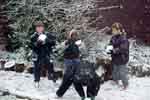Play in Educational Settings Consultation
Paper
Appendix 1
Back to the main Paper
Criteria for an enriched play environment
The following criteria for an enriched play environment appear
in 'Best
Play: what play provision should do for children.' The examples
given in each section are in no sense exhaustive, merely indicative.
(The criteria are adapted from those given in B. Hughes 'Play Environments:
A Question of Quality', published by PLAYLINK)
- A varied and interesting environment. Examples: things
at different levels, spaces of different sizes, places to hide,
trees and bushes as well as things that have been made, places
to inspire mystery and imagination.
- Challenge in relation to the physical environment. Examples:
activities which test the limits of capabilities, rough and tumble,
sports and games, chase.
- Playing with the natural elements - earth, water, fire, air.
Examples: campfires, digging, playing snowballs, flying kites.
- Movement - e.g. running, jumping, rolling, climbing, balancing.
Examples: beams and ropes, soft mats, bike riding, juggling equipment,
ladders, space.
- Manipulating natural and fabricated materials. Examples:
materials for art, cooking, making and mending of all kinds; building
dens; making concoctions; using tools; access to bits and pieces
of all kinds.
- Stimulation of the five senses. Examples: music making,
places where shouting is fine, quiet places, different colours
and shapes, dark and bright places, cooking on a campfire, rotting
leaves, a range of food and drink, objects that are soft, prickly,
flexible, large and small.
- Experiencing change in the natural and built environment.
Examples: experiencing the seasons through access to the outdoor
environment; opportunities to take part in building, demolishing,
or transforming the environment.
- Social interactions. Examples: being able to choose
whether and when to play alone or with others, to negotiate, co-operate,
compete and resolve conflicts. Being able to interact with individuals
and groups of different ages, abilities, interests, gender, ethnicity
and culture.
- Playing with identity. Examples: dressing up, role play,
performing, taking on different kinds of responsibility.
- Experiencing a range of emotions. Examples: opportunities
to be powerful/powerless, scared/confident, like/disliked, in/out
of control, brave/cowardly.
|
|



